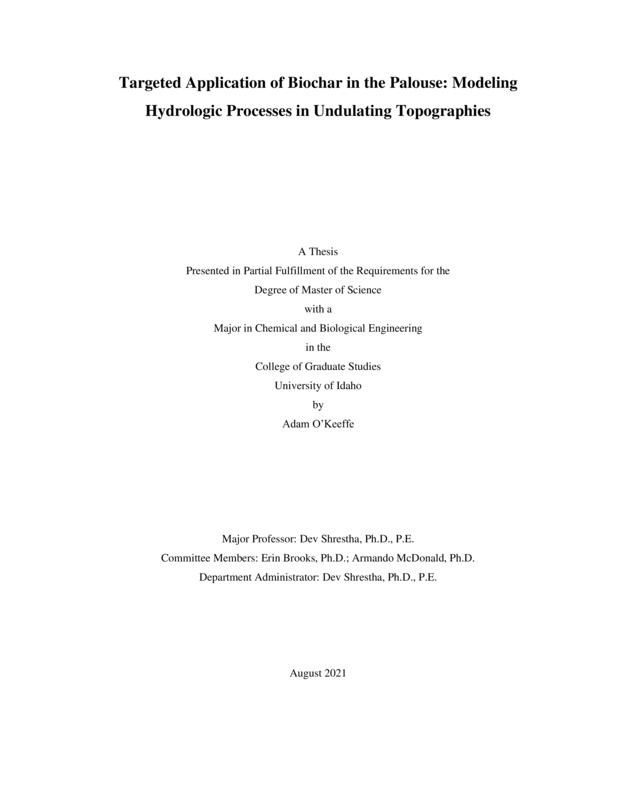Targeted Application of Biochar in the Palouse: Modeling Hydrologic Processes in Undulating Topographies
O'Keeffe, Adam. (2021-08). Targeted Application of Biochar in the Palouse: Modeling Hydrologic Processes in Undulating Topographies. Theses and Dissertations Collection, University of Idaho Library Digital Collections. https://www.lib.uidaho.edu/digital/etd/items/okeeffe_idaho_0089n_12181.html
- Title:
- Targeted Application of Biochar in the Palouse: Modeling Hydrologic Processes in Undulating Topographies
- Author:
- O'Keeffe, Adam
- ORCID:
- 0000-0002-5955-0846
- Date:
- 2021-08
- Keywords:
- Biochar Engineering Hydrologic modeling Precision Agriculture Soil Hydrualic properties
- Program:
- Biological & Agricultural Engineering
- Subject Category:
- Agriculture engineering; Bioengineering; Hydrologic sciences
- Abstract:
-
The use of biochar as a soil amendment has gained great interest among academics, researchers, and private industry over the recent years. Biochar is a carbon rich substance that is made from thermochemical conversion of biomass. It is rich in carbon and nitrogen, two components of soil organic matter, that when introduced into the soil has shown to be beneficial to soil fertility, water retention, and crop yields. Currently biochar is cost prohibitive for large scale amendment to Palouse farmland. In this thesis, we first hypothesize the use of biochar as a precision agriculture technique. Targeted application of biochar to eroded Palouse soils would potentially allow for restoration of the soils by increasing soil health, water retention, and crop yield. To determine if biochar has potential as a precision agriculture technique, a combination of laboratory experimentation and hydrologic modeling was employed. A finite element analysis model was developed in MATLAB to simulate how moisture is redistributed in an undulating topography. Two types of biochar were amended to a standard Palouse silt loam soil, at two different concentrations, to measure how biochar affects the matric potential, hydraulic conductivity, and diffusivity of a silt loam soil. The developed model utilizes the measured soil hydraulic properties to simulate the effects of biochar on water redistribution. This model is driven by evaporation off the simulated soil profile. A novel equation for modeling evaporation/evapotranspiration was developed based on the theory of convective heat transfer, which is utilized in the model. This work then proceeded to validate the model output by comparing simulated and measured soil moisture data. The developed evaporation equation was then refined through linear regression analysis to provide a more comprehensive equation that better simulates evaporation and evapotranspiration. This model, prior to the linear regression analysis, yielded positive results. Amending Palouse silt loam soil with biochar showed an increase retention across both amendment types and concentrations. The simulation showed that more moisture was retained in and around the amendment area. This is likely due to biochar increasing the water retention of the soil in both wet and dry conditions and apparent reduction in hydraulic conductivity in saturated conditions. Finally, this work culminated in the exploration of biochar amendment on the greater hydrologic processes in the region. In the Palouse, argillic and fragipan horizons form restrictive layers in the soil profile that drive subsurface hydrology. A soil moisture routing (SMR) model, based on water balance principles, was developed to explore biochar amendment in a more complex soil profile. This model showed biochar was able to increase the ET from the profile while reducing runoff.
- Description:
- masters, M.S., Biological & Agricultural Engineering -- University of Idaho - College of Graduate Studies, 2021-08
- Major Professor:
- Shrestha, Dev
- Committee:
- Brooks, Erin ; McDonald, Armando
- Defense Date:
- 2021-08
- Identifier:
- OKeeffe_idaho_0089N_12181
- Type:
- Text
- Format Original:
- Format:
- application/pdf
- Rights:
- In Copyright - Educational Use Permitted. For more information, please contact University of Idaho Library Special Collections and Archives Department at libspec@uidaho.edu.
- Standardized Rights:
- http://rightsstatements.org/vocab/InC-EDU/1.0/

